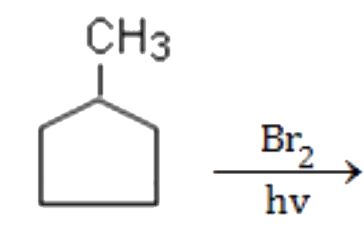When ethylbenzene is brominated, then which of the following products can be obtained in major amounts




The correct Answer is:B, C
To solve the question regarding the bromination of ethylbenzene and the major products formed, we can follow these steps:
Step 1: Understand the Structure of Ethylbenzene
Ethylbenzene consists of a benzene ring attached to an ethyl group (C2H5). The structure can be represented as follows:
C6H5|CH2|CH3
Step 2: Identify the Reaction Conditions
In this case, we are performing bromination without a Lewis acid catalyst. This is important because the presence of a Lewis acid would facilitate electrophilic aromatic substitution, leading to bromination on the benzene ring.
Step 3: Determine the Site of Bromination
Since we are not using a Lewis acid, the bromination will occur on the alkyl side (the ethyl group) rather than the aromatic benzene ring. The ethyl group can undergo free radical bromination.
Step 4: Analyze the Alkyl Group
The ethyl group (C2H5) has two types of hydrogen atoms:
- 3 primary hydrogens (attached to the terminal carbon)
- 2 secondary hydrogens (attached to the carbon that is bonded to the benzene ring)
When bromination occurs, the more stable secondary radical will be favored over the primary radical. Therefore, bromination will predominantly occur at the secondary carbon.
Step 5: Predict the Major Product
The major product of the bromination of ethylbenzene will be 1-bromo-ethylbenzene, where the bromine atom replaces one of the secondary hydrogen atoms on the ethyl group.
Conclusion
Thus, the major product obtained from the bromination of ethylbenzene is 1-bromoethylbenzene.
Ethylbenzene consists of a benzene ring attached to an ethyl group (C2H5). The structure can be represented as follows:
In this case, we are performing bromination without a Lewis acid catalyst. This is important because the presence of a Lewis acid would facilitate electrophilic aromatic substitution, leading to bromination on the benzene ring.
Since we are not using a Lewis acid, the bromination will occur on the alkyl side (the ethyl group) rather than the aromatic benzene ring. The ethyl group can undergo free radical bromination.
The ethyl group (C2H5) has two types of hydrogen atoms:
- 3 primary hydrogens (attached to the terminal carbon)
- 2 secondary hydrogens (attached to the carbon that is bonded to the benzene ring)
The major product of the bromination of ethylbenzene will be 1-bromo-ethylbenzene, where the bromine atom replaces one of the secondary hydrogen atoms on the ethyl group.
Thus, the major product obtained from the bromination of ethylbenzene is 1-bromoethylbenzene.
Topper's Solved these Questions
- HYDROCARBONBOOK - ERRORLESS CHAPTER - HYDROCARBONEXERCISE - JEE SECTION (Reasoning type questions)
4 Videos
- HYDROCARBONBOOK - ERRORLESS CHAPTER - HYDROCARBONEXERCISE - JEE SECTION (Comprehension type questions)
14 Videos
- HYDROCARBONBOOK - ERRORLESS CHAPTER - HYDROCARBONEXERCISE - JEE SECTION (Only one choice correct answer)
93 Videos
- HALOGEN CONTAINING COMPOUNDBOOK - ERRORLESS CHAPTER - HALOGEN CONTAINING COMPOUNDEXERCISE - Critical Thinking (Jee (Advanced) 2018)
1 Videos
- IONIC EQUILIBRIUMBOOK - ERRORLESS CHAPTER - IONIC EQUILIBRIUMEXERCISE - JS Jee Section (JEE Advanced (Numeric answer type question))
1 Videos
Similar Questions
Knowledge Check
In which of the following reaction cyanide will be obtained as a major product?
APh−O∣∣C−CH3NH2−NH2−−−−−−→BPh−O∣∣C−NH2NaOH−−−→Br2CPh−O∣∣C−NH2P4O10−−−→DPh−O∣∣C−O−HSOCl2→NH3−−→In which of the following reaction cyanide will be obtained as a major product?
APh−O∣∣C−CH3(i)LiAlH4ˆ(ii)H3O(+)→BPh−O∣∣C−NH2NaOH−−−→Br2CPh−O∣∣C−NH2P4O10−−−→DPh−O∣∣C−O−HSOCl2−−−→NH3−−→In which of the following reaction cyanide will be obtained as a major product ?
APh−O||C−CH3(i)LiAlH4−−−−−−→(ii)H3O+BPh−O||C−NH3NaOH−−−→Br2CPh−O||C−NH3P4O10−−−→DPh−O||C−O−HSOCl2−−−→NH3−−→
Which of the following major product can be obtained from Gabriel phthalimide synthesis?
View SolutionWhich product can't be obtained in following reaction ?

View SolutionIn which of the following reaction 1,3-butadiene will be obtained as a major product?
View SolutionIn the following reaction

The major product obtained is :
View Solution
Major product obtained in this reaction is:
View Solution

